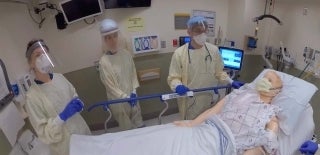
360° Immersive VR Video Experience: Resuscitation of a COVID-19 Patient with Respiratory Failure
This immersive 360 degree video takes you inside a hospital emergency department and shows you, using pop-up text, the best practices learned by medical staff in New York and Philadelphia for treating COVID-19 patients suffering from respiratory failure. It can be viewed on an ordinary computer screen or with a virtual reality headset such as the inexpensive Google Cardboard.
© 2020 Weill Cornell Medicine, New York Presbyterian Hospital, and The Trustees of the University of Pennsylvania.
- Use your smartphone to view in 360 with an inexpensive VR headset such as the Google Cardboard.
- First download the YouTube App on your phone.
- Load this video into the YouTube App.
- Press the PLAY button, and then press the "VR goggle icon" in the bottom right hand corner.
- Close your phone into the headset.
- Looking through the eyepieces, you can turn your head LEFT, RIGHT, UP, and DOWN to watch the immersive video.
If you have a dedicated VR headset (e.g. Oculus, HTC Vive, etc), there are a number of apps to play 360 YouTube content:
- DeoVR for the Rift.
- Vive and YouTube VR for the Oculus Go.
- Load the YouTube video.
- Choose the highest resolution your computer can comfortably play (e.g. 1040sHD) from the gear icon on the bottom right corner.
- Smartphones and tablets have internal motion detectors that allow you to experience some of the immersiveness of the video without a headset.
- Load the video in the YouTube app, press PLAY, hold the screen in front of you and you can turn the phone to look UP, DOWN, LEFT, and RIGHT.
Disclaimer: The information contained in this video content is for informational and educational purposes only. The video content is not intended to be a substitute for professional medical advice, diagnosis, or treatment. The information contained in this video content represents the views and opinions of the original creators and does not necessarily represent the views or opinions of Weill Cornell Medicine, New York Presbyterian Hospital, and the University of Pennsylvania. Although we have attempted to provide accurate and up-to-date information, no guarantee can be made to that effect. Weill Cornell Medicine, New York Presbyterian Hospital, and the University of Pennsylvania do not make any representation or warranties with respect to the accuracy, applicability, fitness, or completeness of the video content. Weill Cornell Medicine, New York Presbyterian Hospital, and the University of Pennsylvania hereby disclaims any and all liability to any party for any direct, indirect, implied, punitive, special, incidental, or other consequential damages arising directly or indirectly from any use of the video content, which is provided as is, and without warranties.
